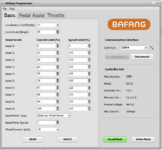Awhile ago, perhaps even on this very thread, a member alluded to the fact that gearing had a big effect on how the programming is set up. Personally I haven't made that connection because in general what I found right away is that an M620 rewards an active spin of the cranks. My setup is a 36t N/W on a Christini spider, which is lighter than stock, with the11/50 12spd cassette that came with the bike.
For sure, that's plenty o' gears!


The need for programming specific to certain gear ratios, comes in primarily at the extreme minimum & maximum ratios.
Drastically different end ratios will likely want different tuning, of the PAS percentiles & the Torque tab's Start\Full\Return\Min\Keep\Decay settings, especially if the gearing uses small (32 tooth) or large (≥48 tooth) chainrings.
Then to a lesser extent, consider that the m620's torque response levels are adjustable only within six Speed% ranges, as defined by the m620's motor controller: 0%, 20%, 40%, 60%, 80%, 100%.
Each of these spans has its own Start\Full\Return\Min\Keep\Decay\etc settings.
These separate spans exist so that you can get (for instance) full assist power from relatively little pedal force, up near top speed (when your cadence is high, making full pedal force impossible); while still getting more moderate & precisely nuanced pedal assist percentages, at lower speeds (where it's possible to apply
way more than the sensor's maximum 60 Kg!).
So, if you have very few gear ratios to shift between, or spend a lot of time at a transition point between those ranges of speed, large differences in the settings for 20% & the settings for 40%, may produce a noticeable "wrong gear"/"wrong assist level" feeling, in certain gears, wherein the assist level is too low despite moderate speed & then mysteriously fine just a few MPH faster.
This is most noticeable at very low (single digit percentage) assist levels.
With 12 speeds, you may have no extreme jumps in gear ratio at moderate & higher speeds. So, "matching" the five transition points between the six Speed% ranges of Torque settings, to get Torque sensitivity appropriate for each Speed% range, would be a non-issue, because you've got twice as many gear ratios as you have Torque sensitivity levels!
Riders with drivetrains providing just 6 or 7 gear ratios, may find that getting the Start\Full\Return\Min\Keep\Decay settings for each Speed% range, to match up well with the gear ratios they're using at each of those speeds, is critical for getting relatively uniform or appropriate-feeling response to pedal force, across all speeds.
(Users who ride at very high cadence, or rarely use pedal assist modes capped at <20 percent power, may never notice the transition points at all.)
If you set the MaxCur% for Spd0, to 50...
& set the MaxCur% for Spd20, to 100...
& set the MaxCur% for Spd40, to 50...
& set the FullKg for all three ranges, to 1...
(& manage to get rolling without stripping anything...)
the transition points, between Spd0, Spd20, & Spd40, will
definitely feel noticeable enough to pinpoint, then!?

